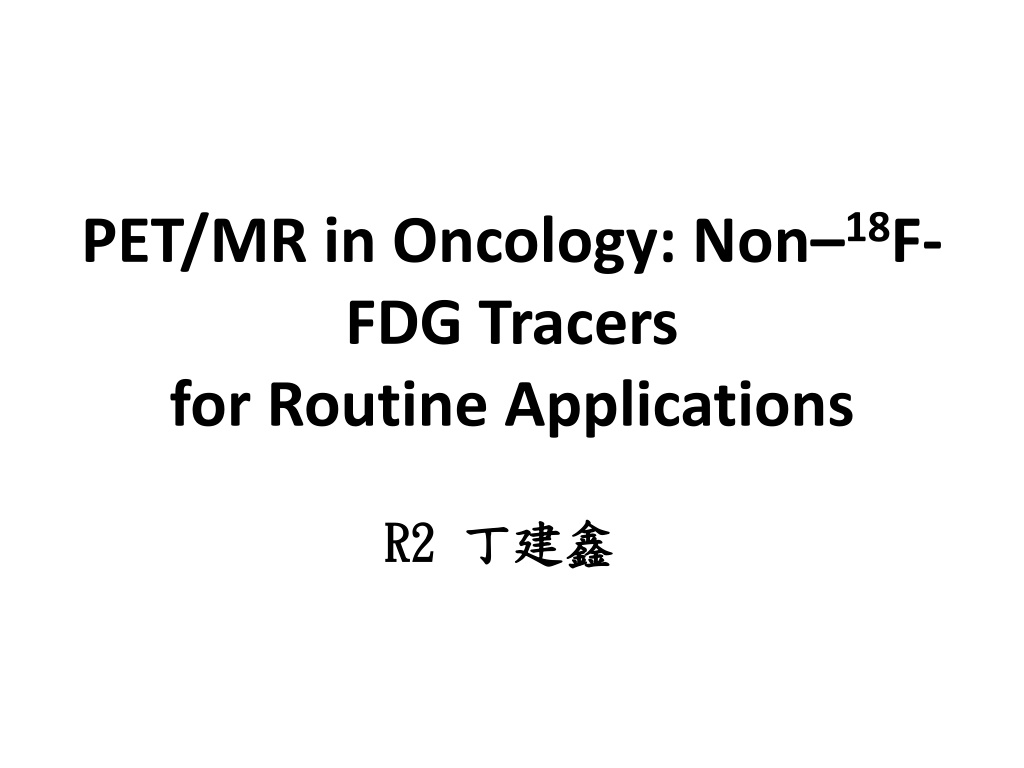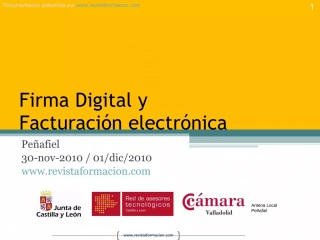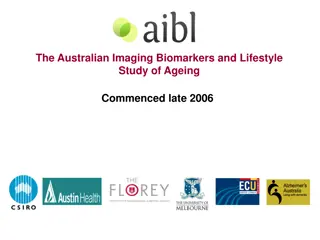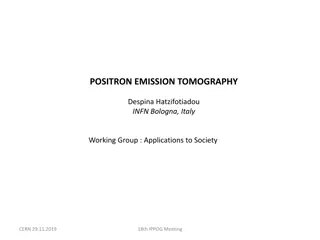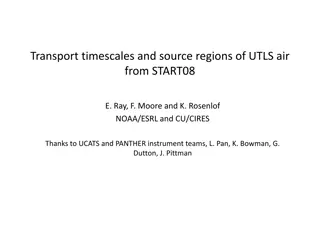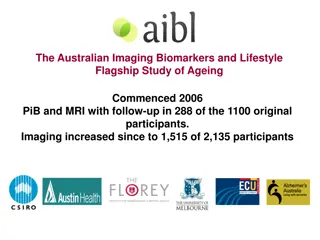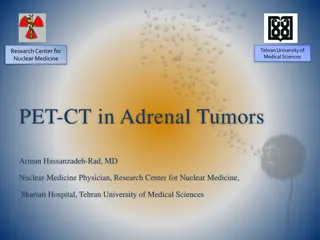Advances in Non-18F-FDG Tracers for PET/MR Imaging in Oncology
Explore the emerging role of non-18F-FDG tracers in PET/MR imaging for oncology, focusing on their use in detecting neuroendocrine tumors and prostate cancer. Learn about the potential benefits of these tracers and the challenges they address in tumor localization and staging.
Download Presentation

Please find below an Image/Link to download the presentation.
The content on the website is provided AS IS for your information and personal use only. It may not be sold, licensed, or shared on other websites without obtaining consent from the author. Download presentation by click this link. If you encounter any issues during the download, it is possible that the publisher has removed the file from their server.
E N D
Presentation Transcript
PET/MR in Oncology: Non18F- FDG Tracers for Routine Applications R2 R2
Introduction PET/MR and PET/CT in oncology. 68Ga labeled somatostatin analogs for neuroendocrine tumors. Choline-labeled isotopes for prostate cancer. Soft-tissue contrast, perfusion, and diffusion- weighted imaging.
Introduction In this review, we cover the available first experiences with oncologic PET/MR in clinical routine using non 18F-FDG tracers and then outline the potential value. In parts of this article, we also refer to our own experiences with PET/MR that have not yet been published and thus should not be misinterpreted as evidence-based knowledge but might be informative for current and future users of PET/MR.
NETs Incidence rate in USA is increasing from 10.9 per million to 52.4 per million from 1973 to 2004 (38 per million persons per year in 2004). Localization gastroenteropancreatic tract, lung and, rarely, the ovary and thymus. NETs are often difficult to localize using conventional morphologic imaging techniques, because they can occur throughout the body and might still be relatively small, although the patient already presents with first symptoms.
NETs A feature common to almost all NETs is the expression of somatostatin receptors, providing a unique target for their diagnosis and treatment. Therefore, radiolabeled somatostatin analogs have been used for the detection of NETs with a high sensitivity and specificity for many years as somatostatin receptor scintigraphy. However, SRS has several limitations: the spatial resolution of scintigraphy including SPECT is limited, and moreover the examination is relatively time-consuming.
NETs Several studies have indicated that somatostatin receptor ligand PET/CT has a significantly higher performance than SRS and CT in the detection and localization of the primary tumor and staging of NETs. Despite the higher performance of PET than SRS, the detection of small (<5 mm) liver lesions is still impaired because of the substantial physiologic tracer uptake of the liver.
NETs A study comparing PET/CT and whole-body MR imaging showed comparable overall lesion-based detection rates for metastatic involvement in NETs but significantly different organ-based detection rates, with superiority of PET/CT for lymph node and pulmonary lesions and of whole-body MR imaging for liver and bone metastases.
NETs The additional value of DWI in the detection and characterization of NETs is still under debate. We recommend an additional chest CT in low dose if lung metastases are clinically relevant and the patient does not present with previous examinations.
NETs In summary, SRL PET/MR is one of the promising clinical applications, especially when radiation exposure from CT might be an issue, for example, in younger patients or for repeated follow up examinations. We find SRL PET/MR in our clinical experience most useful when metastatic spread is limited and when the liver and pancreas are the focus of interest.
NETs However, in the beginning for primary staging, a diagnostic CT of the chest is advisable additionally to rule out small lung lesions. In contrast to PET/MR, in our experience SRL PET/CT with diagnostic dual-phase CT is more useful for indications in which the focus is on mesenteric/peritoneal lesions or when there is widespread metastatic disease.
Prostate Cancer Currently, different guidelines name multiparametric MR imaging as the modality of choice for detection of primary prostate cancer, especially in the setting of primary negative biopsies. In addition, depending on the availability of the different tracers used for prostate cancer imaging and the local conventions, PET/CT is used for restaging of recurrent disease and individually also for staging of primary disease.
Prostate Cancer The development of PET/MR holds great promises to improve the diagnostic accuracy of prostate cancer. MR imaging shows excellent soft- tissue contrast and a high spatial resolution, can clearly discriminate the peripheral from the central and transition zone, and can provide functional information for DWI and dynamic contrast-enhancement series. The PET part of PET/MR can provide molecular information depending on the specific tracer used.
Prostate Cancer 18F-FDG PET has some utility in castrate-resistant metastatic prostate cancer but not in the staging of primary prostate cancer or in the detection of early recurrence. Furthermore, the renal excretion of radiotracer and accumulation in the urinary bladder can impair the visualization in the pelvis. Several new tracers for targeting prostate-specific membrane antigen are now available for PET, offering the possibility of even more tumor- specific imaging.
Prostate Cancer 11C-choline is a radiopharmaceutical potentially useful for prostate imaging. In contrast to 18F-marked radiotracers, several studies verified that the urinary activity of 11C- choline is negligible, allowing a much better delineation of the prostate fossa. One major disadvantage of 11C-labeled radiotracers is the comparatively short half-life of only 20 min, limiting the use of this tracer to centers having an on-site cyclotron.
Prostate Cancer Compared with 18F-FDG, 11C-choline shows a considerably higher uptake in both primary prostate cancer and metastatic sites. However, 11C-choline PET/CT has shown limitations for the detection of primary prostate cancer because of the insufficient differentiation between benign changes such as prostatitis, high-grade intraepithelial neoplasia, or prostatic hyperplasia.
Prostate Cancer In addition, especially small and rind-like tumors can often not be visualized. Despite promising initial results, several recent publications state a limited diagnostic accuracy, mainly because of a low sensitivity of 11C-choline in detecting lymph node metastases in primary prostate cancer.
Prostate Cancer In the restaging of prostate cancer recurrence, 11C-choline PET/CT is regarded as a valuable tool for the detection of local regional disease as well as nodal and bone metastases. However, the detection rate of 11C-choline PET/CT depends on the serum PSA value in patients with biochemical recurrence of prostate cancer after primary therapy, with the detection rate consistently improving from 36%for a PSA value of less than 1ng/mL to 73% for a PSA value of 3 ng/mL or more.
Prostate Cancer Promising results for the use of 11C-choline PET/MR for restaging prostate cancer can be derived from a recent study stating that multiparametric MR is superior to 11C-choline PET/CT in the detection of local recurrence. Regarding lymph node metastases, preliminary results indicate a similar detection rate between 11C-choline PET/MR and PET/CT.
Prostate Cancer For primary prostate cancer and its differentiation from benign changes, it is difficult to predict whether combining multiparametric MR imaging and 11C-choline PET may potentially overcome the limitation of 11C-choline PET/CT. 11C-choline PET/MR for biopsy.
Prostate Cancer The main indication for 11C-choline PET/MR in prostate cancer will be the evaluation of patients with a rising PSA serum level because the detection rate of 11C-choline PET/CT for the recurrence of prostate cancer is known to be limited in patients with low PSA values and a long doubling time.
Prostate Cancer PSMA is a cell surface protein with high expression in prostate cancer cells. In a preliminary study, the biodistribution of the novel 68Ga-PSMA tracer and its ability to detect prostate cancer lesions was already analyzed using PET/CT. Lesions suggestive of prostate cancer presented with excellent contrast as early as 1 h after injection, with high detection rates even at low PSA levels.
Prostate Cancer Since 11C-choline is known to be not very specific, also showing uptake in benign prostate conditions such as hyperplasia, 68Ga-labeled PSMA ligand might be superior to choline tracers as it obtains a high and specific contrast. and are highly accumulated in the bladder, thus small local recurrences might be missed by PET/CT. In these difficult cases, PET/MR offers the potential of additional function information from multiparametric MR. 68Ga-labeled PSMA ligands are renally excreted
Bone Metastasis The skeletal system is one of the most common locations for metastasis from primary tumors such as breast, lung, thyroid gland, and prostate cancer.
Bone Metastasis 18F-fluoride is a tracer that mainly depicts blood flow and osteoblastic activity. After intravenous administration, 18F-fluoride is distributed through the bone capillaries and becomes bound by chemisorption at the surface of bone crystals where they form the mineral fluoroapatite within the bone, especially at sites of bone remodelling. 18F-fluoride allows imaging shortly (~30 min) after intravenous administration, in contrast to the significantly longer uptake times of 99mTc-labeled bisphosphonates.
Bone Metastasis 18F-fluoride PET shows an elevated sensitivity for both osteoblastic and lytic lesions,compared with bone scintigraphy. Although the 18F-fluoride uptake mechanism corresponds to osteoblastic activity, it is also highly sensitive for the detection of lytic and early marrow-based metastases. The reactive osteoblastic activity, which accompanies lytic lesions and malignant marrow deposits, is reflected by increased uptake of 18F-fluoride in the periphery of the lesions, even when minimal.
Bone Metastasis However, several studies have analyzed 18F- fluoride uptake in patients with malignant and benign diseases and showed that it is not possible to differentiate benign from malignant lesions based on the intensity of 18F-fluoride uptake. Lesions detected on 18F- fluoride PET, therefore, often require correlation with morphologic CT or MR imaging.
Bone Metastasis Thus, combined PET/MR imaging can offer an important tool for the early detection of bone metastasis, combining the superb imaging lesion-to-background ratio of 18F-fluoride PET and the high accuracy of unenhanced T1- weighted images in demonstrating the bone marrow infiltration of metastatic disease.
Bone Metastasis A potential additional advantage of 18F- fluoride consists in the evaluation of therapy response such as chemotherapy or radiation therapy in bone metastases. When solely MR imaging is used, it has to be considered that necrotic bone metastases may remain virtually unchanged in morphology or signal characteristics. Additionally, reduction in tumor size may be delayed and is therefore not a sensitive tool for therapy response.
Bone Metastasis Though combined whole-body PET/MR may overcome this limitation because of the additional metabolic information of 18F- fluoride. MR imaging can also add valuable information in cases when initially 18F-fluoride uptake might be increased after the start of therapy (flare phenomenon).
Conclusion This article provides an overview of non 18F-FDG PET tracers already evaluated in a PET/MR setting and their potential application in clinical routine. PET/MR is a promising new imaging tool, especially for the diagnostic work-up in patients with cancer, delivering a sensitive whole-body survey, combining molecular, functional, and anatomic data in only 1 examination. Especially because the list of radiotracers is continuously increasing, PET/MR has great potential in a more comprehensive, more accurate, and earlier diagnosis of various tumors.
Conclusion As discussed in this article, oncologic PET/MR using non 18F-FDG tracers is potentially most valuable for NETs primarily involving the liver or pancreas and for recurrent prostate cancer. Further prospective studies have to evaluate the most appropriate clinical applications. The potential diagnostic benefit, compared with existing diagnostic techniques, technical feasibility, practicality, and cost have to be considered.
